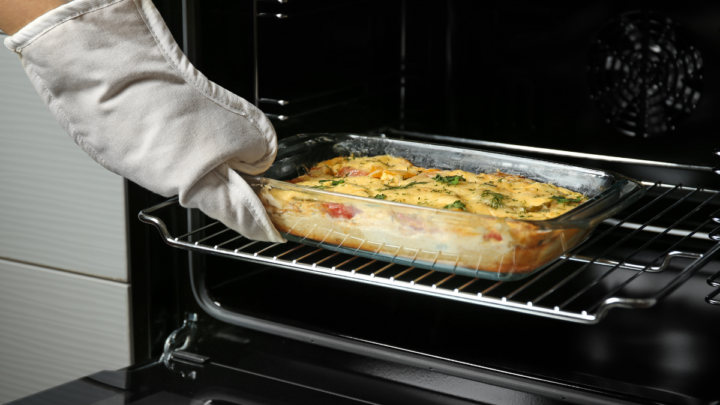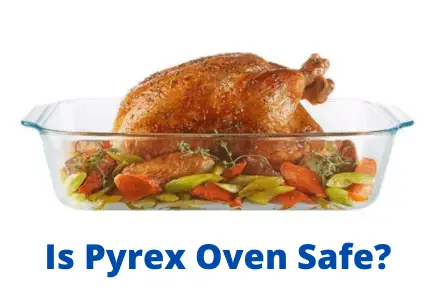You might wonder if Pyrex is a good choice for baking among the many options available. In this article, you will learn if a Pyrex oven is safe, the differences between old and new Pyrex, and how to bake using a Pyrex bowl.
Your kitchen can get messy and cluttered, but you can make it easier to manage with the right baking tools. One way to do this is by getting rid of some of the unnecessary items. You can start by having a few essential baking dishes that you can use safely.
If you’re looking for a classic baking dish, go for an oven-safe ceramic or glass one. This will work well for making French Brioche Toast Casserole or other similar dishes. However, if you prefer metal bakeware, you must adjust the oven temperature and baking time to get the best results.
For even more convenience, consider investing in a high-quality borosilicate Pyrex pan. These pans can be used in ovens and microwaves, as well as in your fridge or freezer. They’re versatile!
What is Pyrex glass?
Pyrex is a brand of glassware that has been around since 1915. It’s important to understand that Pyrex is a type of glass, so you shouldn’t confuse the brand with the material itself.
When we talk about Pyrex dishes, we’re referring to the type of glassware made by the Pyrex brand. It’s become an iconic kitchen staple over the years!
Old Pyrex vs New Pyrex
Have you ever wondered if there are different types of Pyrex? The answer is yes! Initially, Pyrex was made by a company called Corning using a kind of glass called borosilicate. This glass is solid and can handle sudden changes in temperature without breaking.
However, in 1998, Corning sold the Pyrex brand to another company called World Kitchen. From then on, Pyrex dishes were made with a different type of glass called tempered soda-lime glass. This glass is strong and can handle high temperatures but could be more durable than borosilicate glass.
If you come across Pyrex dishes made before 1998, they’re probably made with borosilicate glass. These are sometimes referred to as “old Pyrex.” Nowadays, Pyrex dishes are made with tempered glass and will have the pyrex® logo on them.
But wait, there’s still more to the story! In France, a company called Le Pyrex was making borosilicate glass products as far back as 1922. The Pyrex brand in Europe still uses borosilicate glass today!
Is Pyrex oven safe?
Is Pyrex safe to use in the oven? The answer is yes; both old and new Pyrex brands label their glass products as oven-safe, which means you can safely use them in the range.
However, it’s important to note that Pyrex glass products can only handle so much heat. It’s best to use them in temperatures up to 425°F (218°C) to be safe, even though they can handle up to 500°F (260°C).
It’s also essential to avoid sudden temperature changes, such as putting a cold Pyrex dish in a hot oven or pouring cold water into a hot Pyrex dish. These changes can cause the glass to shatter.
While Pyrex is safe for the oven, it’s not recommended in a toaster oven, under the broiler, or on a grill.
Can Pyrex go in the oven?
Pyrex dishes with the pyrex® or PYREX® logos on the bottom can safely be used for cooking, baking, and reheating food in the oven. However, there are two types of Pyrex: borosilicate PYREX® and tempered glass Pyrex, and they aren’t the same. Borosilicate PYREX® is better because it can handle heat changes up to 396°F (220°C), while tempered-glass Pyrex is more susceptible to heat changes.
Knowing what kind of Pyrex glassware you have to avoid damage is essential. If you’re concerned about thermal shock, choosing borosilicate glass cookware is best. Generally, if you use Pyrex cookware as instructed, baking with it is safe and enjoyable.
Are Pyrex lids oven safe?
Pyrex glass lids with casserole dishes can be used in the oven up to 425°F (218°C) and are safe to use. But it’s important to remember that the same safety precautions that apply to Pyrex glassware also apply to Pyrex glass lids.

Using Pyrex glass lids in the preheated oven allows you to check the food without disturbing the cooking process or temperature. And covering the Pyrex casserole dish can help cook food faster by trapping heat inside the pot, making your food moister. Alternatively, you can use aluminium foil to cover your dish.
Pyrex plastic lids are safe to use for storing food and are BPA-free. However, they are unsafe for the oven but can be used in the microwave. Always check the product manual for more information on how to use Pyrex glassware and lids safely.
Is vintage Pyrex oven safe?
If you have some old Pyrex dishes passed down to you from your grandma, they may hold a special place in your heart. But you might wonder if using them in the oven is safe.
The answer is yes; you can still use vintage Pyrex for cooking if you don’t go above 425°F (218°C) in the oven. However, remember that these dishes may get cracks or chips over time, making them unsafe to use in the range or even for everyday use.
So, it’s best to use them for decoration or display rather than cooking or storing food.
Baking in Pyrex
If you’re wondering if you can use Pyrex glassware for baking, the answer is yes! However, there are some adjustments you need to make to the oven temperature and baking time to ensure the best results.
Since Pyrex is made of glass, it can cause the sides and bottom of your baked goods to brown too quickly. Lower the oven temperature by about 25°F (or 15°C) than your recipe suggests to prevent this.
Also, your baking time will likely be shorter by 5 to 10 minutes. Therefore, it’s best to check your cake’s doneness 10 minutes earlier than your recipe suggests by inserting a toothpick or cake tester into the centre of the cake.
Can Pyrex go from fridge to oven?
The answer to whether you can put Pyrex directly into the oven from the fridge or freezer is generally no. This is because the sudden temperature change can cause thermal shock.
Thermal shock happens when a material experiences stress due to a sudden temperature change. With Pyrex glassware, the heat from the oven can cause the glass to expand and contract at different rates, which can lead to changes in the glass’s structure and even shattering.
While clear Pyrex bowls are generally heat resistant and can withstand some thermal shock, it’s still best to avoid putting frozen Pyrex directly into a hot oven.
Although European PYREX claims that their borosilicate glass dishes can go from freezer to oven with no problems,
it’s still better to be cautious and treat any Pyrex glass dish like any other piece of glass.
Does Pyrex break?
Pyrex is generally strong and durable, and it can withstand high temperatures. However, it can still break under certain circumstances.
If Pyrex is heated unevenly, comes into direct contact with heating elements, or experiences thermal shock, it can break. Dropping Pyrex is also a risk for breakage.
Consumer Reports tested different types of Pyrex made of borosilicate and tempered glass. They found it shattered immediately when the soda-lime Pyrex was removed from a hot oven and placed on a wet granite countertop. On the other hand, the borosilicate Pyrex did not shatter in the same extreme temperature changes.
While tempered soda-lime glass is more susceptible to thermal shock, it is more resistant to breaking when dropped compared to borosilicate glass. Therefore, it’s essential to consider which type of Pyrex glassware to buy.
Tips for using Pyrex
Pyrex is a famous brand of glass bakeware that is durable and heat-resistant but can break if not used correctly.
To keep yourself safe in the kitchen, following some safety tips when using Pyrex is essential.
- First, ensure you’re using genuine Pyrex glassware with the Pyrex logo.
- Check for any chips or cracks in the dish before using it, and avoid using old glass bakeware that might be more prone to breaking in the oven.
- Always preheat your oven before using Pyrex, and
- Don’t exceed a temperature of 425°F (218°C).
- Never heat an empty Pyrex dish in the oven,
- Add a little liquid to the bottom of the dish when using wet ingredients like frozen food to avoid thermal shock.
- Always handle hot Pyrex dishes with dry potholders or oven mitts, and use both hands to avoid dropping the plate.
To avoid thermal shock, follow these four simple rules:
- Let your Pyrex dish come to room temperature before placing it in the oven or vice versa,
- Avoid pouring cold water into a hot Pyrex dish,
- Never place a hot Pyrex dish directly on a wet or cool surface, and
- Don’t use Pyrex on a stovetop, under the broiler, on the grill, or in a toaster oven.
Conclusion
Yes, you can put Pyrex glass in the oven. It’s essential to understand which Pyrex glassware is safe to use in the range and microwave to avoid accidents. You can find a complete guide to using Pyrex glassware safely in the kitchen.
It’s recommended to choose Pyrex products made of borosilicate glass because they are the safest. A wide range of Pyrex dishes is available, from measuring cups to oven-safe bowls, cooking pots, and glass trays.
Also read: Can You Microwave Paper Plates? You don’t have to test it because we already have!
FAQs
Is it safe to place a frozen Pyrex dish in the oven?
Putting a frozen Pyrex dish in the oven is not recommended as it can cause thermal shock, which may result in the shattering of the Pyrex glass.
Is it safe to bake Pyrex at 450 degrees Fahrenheit?
European PYREX cookware is safe to use in the oven at 450 degrees Fahrenheit, but it’s important to note that there is a risk of glass shattering if the oven temperature is increased to 500 degrees.
Can Pyrex bowls be used in the oven?
Pyrex bowls that bear the Pyrex logo are safe to use in the oven for cooking, baking, and reheating food.

















